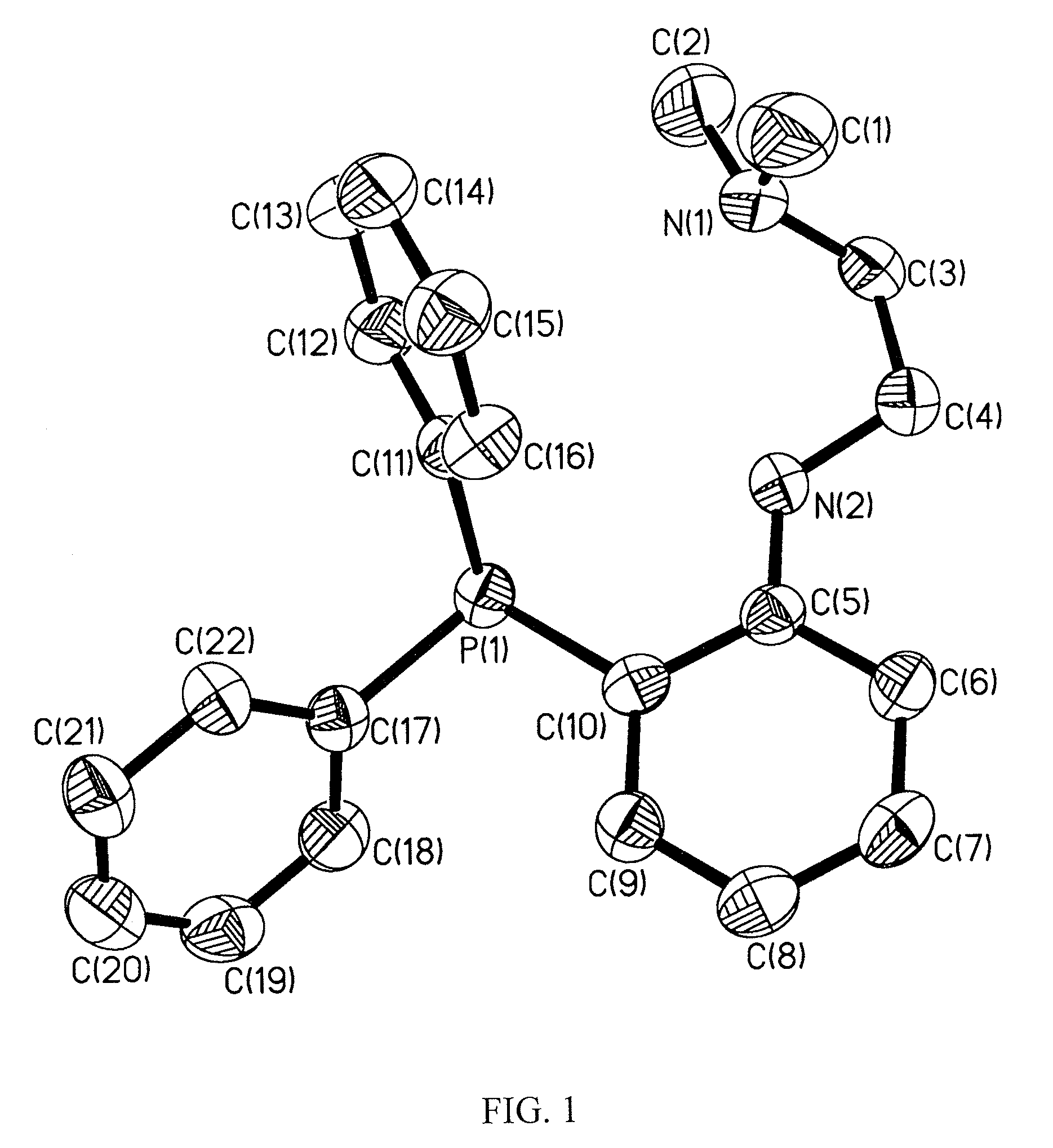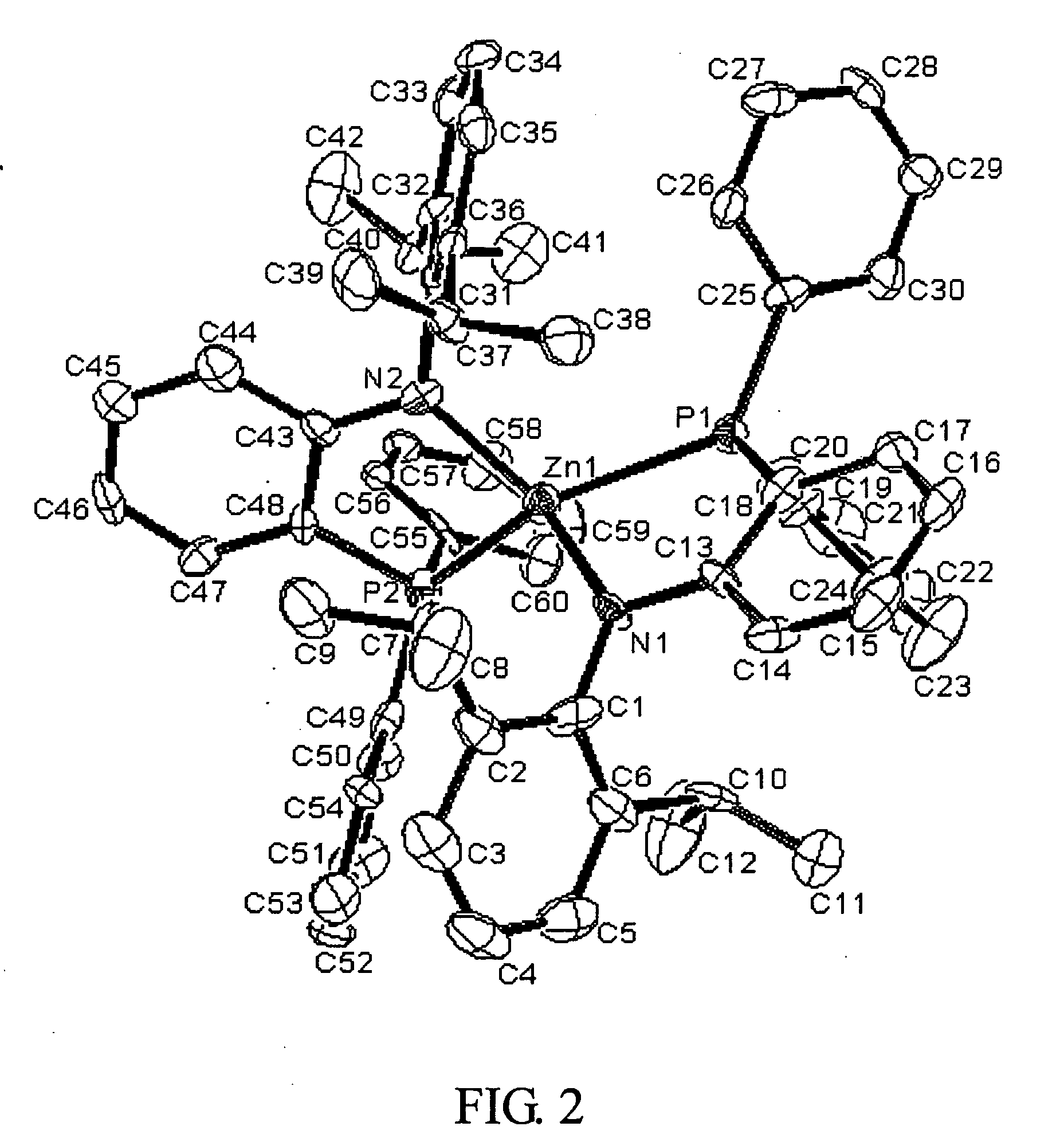Ligands for metals as catalysts for carbon-carbon bond formation
- Summary
- Abstract
- Description
- Claims
- Application Information
AI Technical Summary
Benefits of technology
Problems solved by technology
Method used
Image
Examples
example 1
Synthesis of [NP]2Zn
[0202]General Procedures. Unless otherwise specified, all experiments were performed under nitrogen using standard Schlenk or glovebox techniques. All solvents were reagent grade or better and purified by standard methods. All other chemicals were used as received from commercial vendors. The NMR spectra were recorded on Varian instruments. Chemical shifts (δ) are listed as parts per million downfield from tetramethylsilane and coupling constants (J) are in hertz. 1H NMR spectra are referenced using the residual solvent peak at δ 7.16 for C6D6, and δ7.27 for CDCl3. 13C NMR spectra are referenced using the residual solvent peak at δ 128.39 for C6D6, and δ 77.23 for CDCl3. The assignment of the carbon atoms for all new compounds is based on the DEPT 13C NMR spectroscopy. 19F, 31P and 7Li NMR spectra are referenced externally using CFCl3 in CHCl3 at δ0, 85% H3PO4 at δ0, and LiCl in D2O at δ0, respectively. Routine coupling constants are not listed. All NMR spectra w...
example 2
Synthesis of [PNP]NiZ4
[0210]General Procedures. Unless otherwise specified, all experiments were performed under nitrogen using standard Schlenk or glovebox techniques. All solvents were reagent grade or better and purified by standard methods. All other chemicals were used as received from commercial vendors. The NMR spectra were recorded on Varian instruments. Chemical shifts (δ) are listed as parts per million downfield from tetramethylsilane and coupling constants (J) are in hertz. 1H NMR spectra are referenced using the residual solvent peak at δ 7.16 for C6D6, and δ 7.27 for CDCl3. 13C NMR spectra are referenced using the residual solvent peak at δ 128.39 for C6D6, and δ 77.23 for CDCl3. The assignment of the carbon atoms for all new compounds is based on the DEPT 13C NMR spectroscopy. 19F, 31P and 7Li NMR spectra are referenced externally using CFCl3 in CHCl3 at δ0, 85% H3PO4 at δ 0, and LiCl in D2O at δ 0, respectively. Routine coupling constants are not listed. All NMR spe...
example 3
[0223]Synthesis of [MeNP]NiZ or [iPr—NP]NiZ
[0224]General Procedures. Unless otherwise specified, all experiments were performed under nitrogen using standard Schlenk or glovebox techniques. All solvents were reagent grade or better and purified by standard methods. The NMR spectra were recorded on Varian instruments. Chemical shifts (δ) are listed as parts per million downfield from tetramethylsilane, and coupling constants (J) and peak widths at halfheight (Δν1 / 2) Δare in hertz. 1H NMR spectra are referenced using the residual solvent peak at δ 7.16 for C6D6 and δ 2.09 for toluene-d8 (the most upfield resonance). 13C NMR spectra are referenced using the residual solvent peak at δ 128.39 for C6D6. The assignment of the carbon atoms for all new compounds is based on the DEPT 13C NMR spectroscopy. 31P and 7Li NMR spectra are referenced externally using 85% H3PO4 at δ 0 and LiCl in D2O at δ 0, respectively. Routine coupling constants are not listed. All NMR spectra were recorded at roo...
PUM
| Property | Measurement | Unit |
|---|---|---|
| Structure | aaaaa | aaaaa |
Abstract
Description
Claims
Application Information
 Login to View More
Login to View More - R&D
- Intellectual Property
- Life Sciences
- Materials
- Tech Scout
- Unparalleled Data Quality
- Higher Quality Content
- 60% Fewer Hallucinations
Browse by: Latest US Patents, China's latest patents, Technical Efficacy Thesaurus, Application Domain, Technology Topic, Popular Technical Reports.
© 2025 PatSnap. All rights reserved.Legal|Privacy policy|Modern Slavery Act Transparency Statement|Sitemap|About US| Contact US: help@patsnap.com



